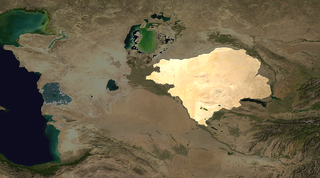
The Kyzylkum Desert is the 15th largest desert in the world. Its name means Red Sand in Turkic languages. It is located in Central Asia, in the land between the confluent rivers Amu Darya and Syr Darya, a region historically known as Transoxania. Today it is divided between Kazakhstan, Turkmenistan and Uzbekistan. It covers about 298,000 km2 (115,000 sq mi).

Therizinosaurus is a genus of very large therizinosaurid that lived in Asia during the Late Cretaceous period in what is now the Nemegt Formation around 70 million years ago. It contains a single species, Therizinosaurus cheloniformis. The first remains of Therizinosaurus were found in 1948 by a Mongolian field expedition at the Gobi Desert and later described by Evgeny Maleev in 1954. The genus is only known from a few bones, including gigantic manual unguals, from which it gets its name, and additional findings comprising fore and hindlimb elements that were discovered from the 1960s through the 1980s.

The Bayan Shireh Formation is a geological formation in Mongolia, that dates to the Cretaceous period. It was first described and established by Vasiliev et al. 1959.

Tsagantegia is a genus of medium-sized ankylosaurid thyreophoran dinosaur that lived in Asia during the Late Cretaceous period. The genus is monotypic, including only the type species, T. longicranialis. The specimen consists of a very partial individual, comprising the skull and lacking postcranial remains. Since it only preserves the skull, Tsagantegia is mainly characterized by its elongated snout and the flattened facial osteoderms, greatly differing from other ankylosaurs.
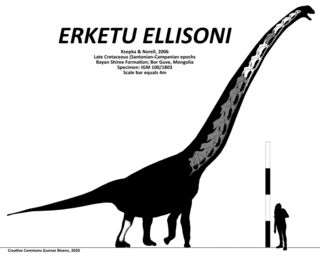
Erketu is a genus of somphospondylan sauropod dinosaur that lived in Asia during the Late Cretaceous roughly between 96 million and 89 million years ago. Its fossils were found in Mongolia between 2002 and 2003 during a field expedition and first described in 2006; later on in 2010 due to some cervicals that were left behind in the expedition. Erketu represents one of the first sauropods described from the Bayan Shireh Formation. The elongated cervical vertebrae of Erketu indicates that it was the sauropod with the longest neck relative to its body size.

Shamosuchus is an extinct genus of neosuchian crocodyliform that lived during the Late Cretaceous (Campanian) period in what is now the Djadokhta Formation of Mongolia, approximately 75 million to 71 million years ago.

The Nemegt Formation is a geological formation in the Gobi Desert of Mongolia, dating to the Late Cretaceous. The formation consists of river channel sediments and contains fossils of fish, turtles, crocodilians, and a diverse fauna of dinosaurs, including birds.
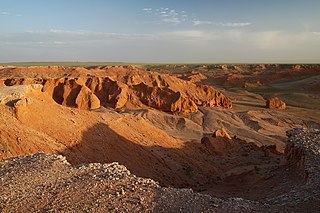
The Djadochta Formation is a highly fossiliferous geological formation situated in Central Asia, Gobi Desert, dating from the Late Cretaceous period, about 75 million to 71 million years ago. The type locality is the Bayn Dzak locality, famously known as the Flaming Cliffs. Reptile and mammal remains are among the fossils recovered from the formation.
Evgeny Aleksandrovich Maleev was a Soviet and Russian paleontologist who did most of his research on reptiles and Asian fossils, such as the naming of the ankylosaur Talarurus and theropods Tarbosaurus and Therizinosaurus along with the family Therizinosauridae.
The Shinekhudag Formation is a geological formation in Dundgov, Mongolia whose strata date back to the Early Cretaceous. Dinosaur remains have been recovered from it. It has formerly been considered Aptian-Albian in age, but more recent research suggests an earlier Berriasian-Hauterivian age.
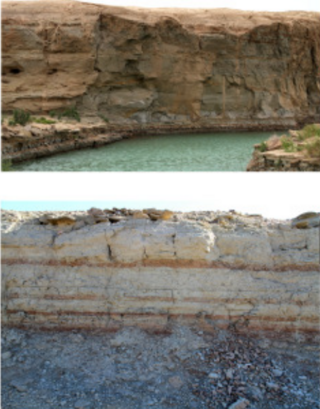
The Tugulu Group is a geological Group in Xinjiang, China whose strata date back to the Early Cretaceous. Dinosaur skeletal remains and footprints are among the fossils that have been recovered from the formation.
The Bostobe Formation is a geological formation in Qaraghandy & Qyzylorda, Kazakhastan whose strata date back to the Late Cretaceous.
The Ulan Malgait Formation is a Late Jurassic geologic formation in Mongolia. Dinosaur remains are among the fossils that have been recovered from the formation, although as of 2004 none have yet been referred to a specific genus.
The Lianmuqin Formation, also transcribed as Lianmugin Formation, and Lianmuxin Formation, is an Early Cretaceous geologic formation composed of "interbedded red green and yellow variegated mudstones and siltstones". Dinosaur remains have been recovered from it.
The Murtoi Formation is a geologic formation in vicinity of Lake Gusinoye in Russia. It was deposited in the late Barremian to the mid Aptian of the Early Cretaceous.
The Ialovachsk or Yalovach Formation is a geologic formation in Kyrgyzstan, Tajikistan and Uzbekistan dating to the Santonian age of the Cretaceous period.
The Jobu Formation is a Cretaceous geologic formation of Late Cenomanian age. Dinosaur remains are among the fossils that have been recovered from the formation, although none have yet been referred to a specific genus. The oldest confirmed tyrannosaurid premaxillary tooth was recovered from the Jobu Formation. The mammal Sorlestes is also known from the formation.
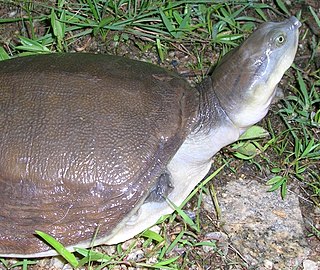
Cyclanorbinae, also known commonly as the flapshell turtles, is a subfamily of softshell turtles in the family Trionychidae. The subfamily is native to Africa and Asia.

Macrobaenidae is an extinct family of turtles, known from the Early Cretaceous to Paleogene of Laurasia. Their relationships to other turtles and whether they form a monophlyletic group are controversial. They are typically interpreted as stem or crown group cryptodires, but some more recent analyses have found them to lie outside crown group Testudines. Macrobaenids can be distinguished from other testudinatans by the presence of a carotid fenestra, cruciform plastron with strap-like epiplastra, and a lack of extragulars.
The Ulaanoosh Formation, formerly Baruunbayan Formation, is a geologic formation in the Ömnögovi Province of southern Mongolia. The formation dates to the Albian to Cenomanian stages of the Cretaceous. The Ulaanoosh Formation has provided fossils of dinosaurs, turtles and dinosaur eggs assigned to Parafaveoloolithus sp.. In 2020, the neoceratopsian Beg tse was described from the alluvial sandstones, mudstones and conglomerates of the formation.












